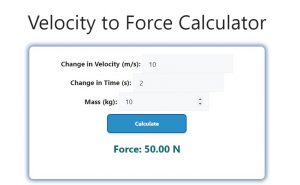About Velocity to Force Calculator (Formula)
The Velocity to Force Calculator is an essential tool in physics and engineering that helps determine the force exerted on an object based on its mass and the change in its velocity over time. Understanding this relationship is crucial in various applications, from automotive engineering to sports science. By accurately calculating force, you can predict the impact of movements, optimize performance, and ensure safety in mechanical systems. This article explains the formula, how to use the calculator, and answers common questions regarding its application.
Formula
The formula for calculating force based on velocity is: Force (F) = mass (m) * (change in velocity (Δv) / change in time (Δt)). In this formula, mass represents the object’s mass, Δv is the change in velocity, and Δt is the time over which the change occurs.
How to Use
Using the Velocity to Force Calculator is straightforward:
- Gather Data: Determine the mass of the object in kilograms and measure the change in velocity (final velocity minus initial velocity) in meters per second.
- Determine Time Interval: Measure the time interval over which the change in velocity occurs in seconds.
- Input Values: Enter the mass, change in velocity, and change in time into the calculator.
- Calculate: Click the “Calculate” button to find the force.
- Interpret the Result: The output will provide the force in newtons (N), indicating how much force is exerted based on the velocity change.
Example
Let’s calculate the force exerted by a 10 kg object that changes its velocity from 5 m/s to 15 m/s over a period of 2 seconds.
- Mass (m): 10 kg
- Initial Velocity (Vi): 5 m/s
- Final Velocity (Vf): 15 m/s
- Change in Velocity (Δv): Vf – Vi = 15 m/s – 5 m/s = 10 m/s
- Change in Time (Δt): 2 seconds
Using the formula:
Force (F) = mass (m) * (change in velocity (Δv) / change in time (Δt))
Force (F) = 10 kg * (10 m/s / 2 s)
Force (F) = 10 kg * 5 m/s²
Force (F) = 50 N
In this example, the force exerted is 50 newtons.

FAQs
- What is the velocity to force calculation used for?
It’s used to determine the force exerted on an object when its velocity changes over time, essential in various physics and engineering applications. - What units are used in this calculation?
Mass is measured in kilograms (kg), velocity in meters per second (m/s), time in seconds (s), and force in newtons (N). - Can I use this calculator for any mass?
Yes, the calculator can be used for any mass, provided it is in kilograms. - How do I measure change in velocity?
Change in velocity is the difference between the final velocity and the initial velocity of the object. - What if the object is stationary?
If the object is stationary, the initial velocity is 0, and you can still calculate force if you have the final velocity and the time interval. - What happens if the time interval is very small?
A very small time interval can lead to large forces; however, practical measurements should consider the limitations of your measuring equipment. - Is this calculation applicable in sports science?
Yes, it helps in analyzing athlete performance and the forces exerted during acceleration or deceleration. - Can this calculator account for friction?
No, this calculation assumes a frictionless environment. Additional calculations are needed to factor in friction. - How does this relate to Newton’s second law of motion?
This calculation is a direct application of Newton’s second law, which states that force equals mass times acceleration (where acceleration is the change in velocity over time). - Can I calculate force without knowing the time?
No, the time interval is essential to determine the rate of change in velocity, which is necessary for calculating force. - What tools can I use to measure velocity?
Velocity can be measured using speedometers, radar guns, or other motion sensing devices. - How accurate do I need to be with my measurements?
Accuracy depends on the application; precise measurements are crucial in high-stakes environments, while rough estimates may suffice in less critical situations. - Can I use this formula for rotating objects?
Yes, but the calculations will differ. In such cases, torque and angular acceleration would be more relevant. - What factors can affect the force calculation?
Variables like air resistance, friction, and incline can affect the actual force experienced by an object. - What is the relationship between force and acceleration?
Force is directly proportional to acceleration; as force increases, acceleration also increases, provided mass remains constant. - Is this tool useful in automotive engineering?
Absolutely, it helps in calculating forces during acceleration, braking, and collisions in vehicle dynamics. - How do I convert force into other units?
Force can be converted to different units (e.g., pounds) using conversion factors; 1 N is approximately 0.2248 pounds. - Can the calculator handle negative values for change in velocity?
Yes, a negative change in velocity indicates deceleration, and the calculator will still provide an accurate force value. - How does mass affect the force calculation?
A larger mass results in a greater force for the same change in velocity, according to the formula. - What if I have more than one object to calculate?
Each object’s force must be calculated separately using their respective mass and change in velocity.
Conclusion
The Velocity to Force Calculator is a powerful tool for accurately determining the force exerted by an object when its velocity changes over time. This calculation is vital in various fields, including physics, engineering, and sports science. By understanding the relationship between mass, velocity, and time, users can optimize designs, improve performance, and enhance safety in mechanical systems. With its straightforward formula and user-friendly application, anyone can effectively leverage this calculator for their specific needs.
